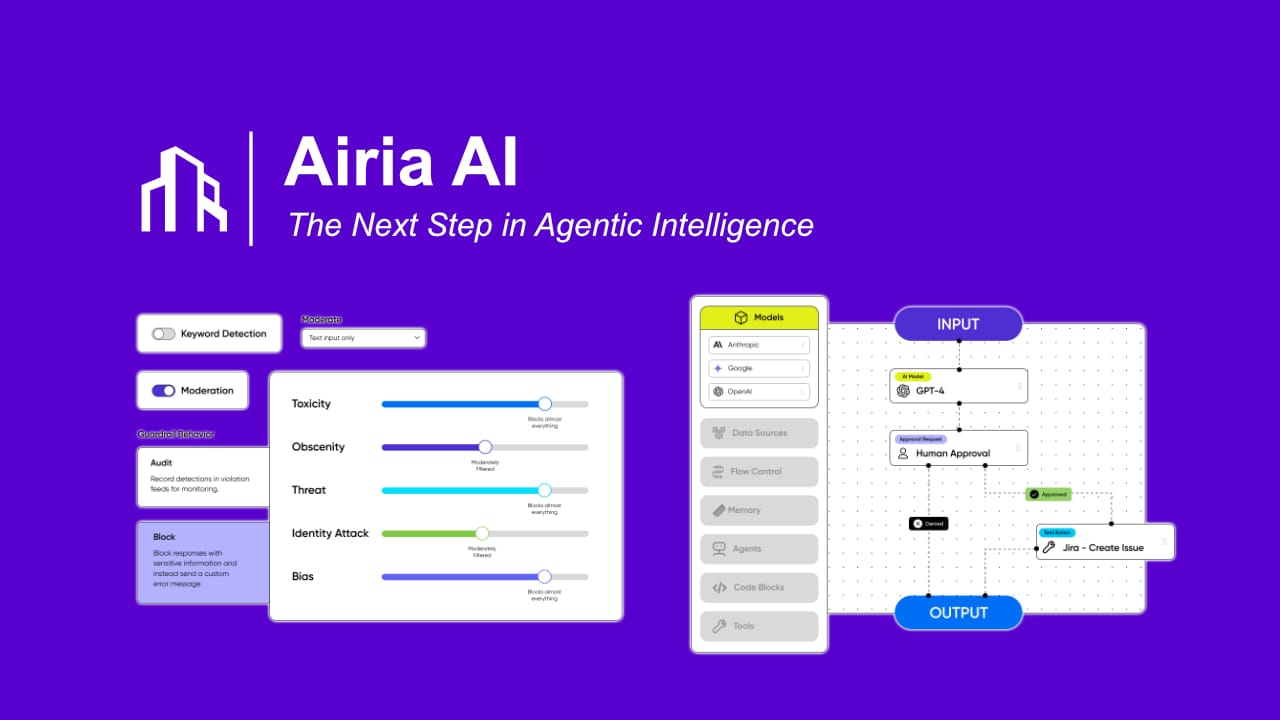Airia AI: The Quiet Contender in the Agentic Intelligence Race

What is Airia AI?
Airia AI is emerging as one of the most intriguing players in the agentic AI space. It isn’t another chatbot or plugin; it’s an orchestration framework that combines retrieval, workflow automation and autonomous reasoning into one platform.
Where most large language models focus on generating text, Airia AI focuses on interpreting workflows. It connects knowledge, intent and actions. In practical terms, it’s a layer between your data ecosystem and the decision logic that drives it.
Technically, Airia AI uses a modular system that connects APIs, databases and automation platforms through intelligent routing. It builds a knowledge graph of your business context and learns how to act on it. This allows the platform to not just answer questions but to execute relevant operations.
The architecture behind Airia AI
Airia AI’s design stands on three architectural pillars:
1. Retrieval Layer
An adaptive search engine that connects to internal and external data sources. It combines semantic search with contextual ranking, so the system can “see” beyond a single chat session and maintain relevance over time.
2. Orchestration Layer
This layer plans multi-step actions. It dynamically decides which tool or API to use for each task, similar to a programmable logic controller for AI workflows. In essence, it brings intelligence to workflow routing.
3. Execution Layer
The execution layer triggers real automations. Airia AI can call Make.com or n8n scenarios directly, or integrate with CRMs, ERPs and analytics tools. This makes it not just conversational, but operationally aware.
Together these components form a context-aware automation system, capable of orchestrating entire business processes rather than single queries.
How Airia AI differs from ChatGPT Agents and Perplexity Comet
The current agentic AI landscape is dominated by OpenAI’s ChatGPT Agents and Perplexity Comet. Both are strong in narrow domains — ChatGPT in structured task execution and Comet in retrieval-based search. Airia AI positions itself as a bridge between the two.
While ChatGPT Agents act on predefined instructions, Airia AI interprets intent and designs a response path dynamically.
While Perplexity Comet retrieves answers, Airia AI retrieves, reasons and executes.
For example, if a user asks:
“Find campaigns with a drop in conversions and adjust the budget accordingly.”
ChatGPT might describe what to do. Airia AI can actually do it — pulling analytics data, running an API check and triggering an automation flow that updates the budget scenario.
Its persistent memory also allows long-term context retention without compromising privacy. Sessions can continue seamlessly because context is stored in encrypted embeddings rather than plain chat logs.
Real-world use cases
Airia AI’s architecture enables advanced applications across multiple business domains:
Operational Intelligence
Integrate business intelligence tools and CRMs for real-time insights. Detect anomalies in sales or operations and automatically trigger corrective actions.
Knowledge-Ops
Convert documentation into a living, searchable intelligence layer. Airia AI connects systems like Notion, Confluence and internal APIs, so teams can query company knowledge contextually.
Customer Operations
Automate triage and routing by predicting ticket intent and linking it to the right department or pipeline in systems like HubSpot or Zendesk.
AI Governance and Compliance
Track reasoning paths, actions and decision logs. This creates transparency for regulated industries and simplifies GDPR and SOC 2 audits.
Each scenario relies on AI orchestration — the capability to plan, retrieve and act, not just generate.
When Airia AI is a good fit
Airia AI makes the most sense for organisations that:
- run multiple data systems or CRMs that require coordination
- already use workflow automation platforms such as Make.com or n8n
- need explainable, logged, and auditable AI decisions
- aim to build persistent, context-aware agents that evolve with data
It’s less suitable for teams looking for simple chatbots, single-step tools or quick plug-and-play solutions. Airia AI’s strength lies in architected intelligence, not surface-level automation.
Integration potential with workflow automation
Airia AI integrates easily with existing automation stacks. A common enterprise setup includes:
- Airia receives an instruction, for example: “Generate onboarding tasks for new clients.”
- It retrieves data from connected systems such as CRM or HR.
- Based on logic weights, it selects the right automation scenario in Make.com or n8n.
- It triggers the workflow and returns structured execution feedback.
This design transforms AI reasoning into deterministic execution, bridging the gap between strategy and automation.
For scale-ups already automating processes, Airia AI becomes the decision-making layer that gives those automations intelligence and adaptability.
Privacy, security and compliance
Airia AI’s data governance strategy is strong. Instead of training global models on user data, it keeps all contextual embeddings inside tenant-specific vaults.
That means no shared data leakage, no uncontrolled fine-tuning, and clear audit trails for compliance teams.
Each reasoning step, API call and action is logged. These logs can feed into observability or SIEM tools, giving businesses a traceable audit line for every automated decision. This satisfies key AI governance and EU AI Act principles.
The bottom line
Airia AI signals where the next phase of intelligent systems is heading: context-aware, compliance-ready orchestration across business ecosystems.
It doesn’t compete with ChatGPT Agents or Perplexity Comet; it operates above them, coordinating logic, retrieval and execution in one cohesive layer.
For organisations already investing in automation, analytics and data governance, Airia AI offers a clear next step — a shift from conversational AI to operational cognition.
